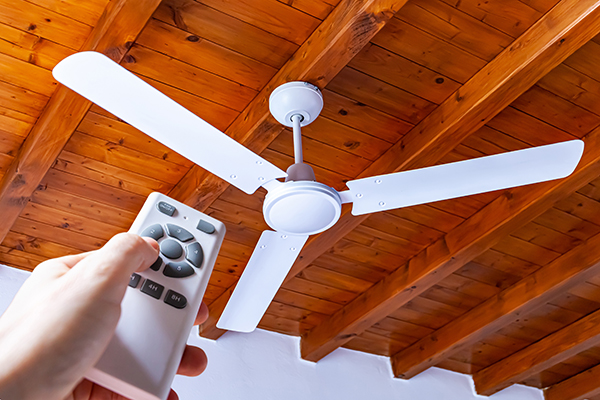Ceiling fans are not just about staying cool in the summer; they’re also secret weapons for warming up your space in the colder months. Beyond the refreshing breeze they provide, most ceiling fans come with a nifty feature – the ability to rotate in different directions. The direction your fan spins can make a significant impact on your room’s temperature depending on the season. In this article, we’ll delve into the world of ceiling fan rotations and unravel everything you need to know about optimizing their direction for each season.
Ceiling Fan Direction for Winter
It may sound counterintuitive, but turning on your ceiling fan during winter can actually contribute to warming up the room—providing, of course, that the fan is set to rotate clockwise. Optimal efficiency is achieved when the fan operates at the lowest speed. Speeding it up might have the opposite effect by cooling the room.
To determine if your fan is rotating clockwise, stand below it and observe if the blades move from left to right. Alternatively, you can stand underneath and check for any air blowing directly on you – an indication that the fan is not in the winter-friendly mode.
The magic happens when the fan, in its clockwise motion, pulls cool air upwards towards the ceiling. This upward movement displaces the stagnant warm air that tends to linger at the top. As a result, the trapped warm air is then guided down along the walls, reaching the floor and creating a cozy, warmer ambiance throughout the room.
Ceiling Fan Direction for Summer
To cool down a room, set your ceiling fan to run in a counterclockwise direction. This creates a downward airflow, circulating cool air in a column throughout the space. It’s advisable to consult your fan’s manual, but in most cases, fans run counterclockwise when the rotation on the motor housing is switched down.
Opting for this setting can even save you a few degrees on the thermostat, as a ceiling fan has the remarkable ability to make a room feel up to four degrees cooler. What’s intriguing is that ceiling fans don’t actively lower the room temperature; instead, they induce a wind chill effect. Essentially, the gentle breeze on your skin creates the sensation of a cooler environment, enhancing comfort without affecting the actual temperature. Which is also why you want to turn ceiling fans off any time you’re not in a room.
Additional Factors for Ceiling Fan Direction
Now that you’re familiar with the optimal fan directions, consider these additional factors for a more tailored experience:
- High Ceilings: For lofty spaces with high ceilings, it’s advisable to leave the fan running counterclockwise consistently, as the breeze generated may go unnoticed. However, the key determinant for effective air circulation is the fan speed. To cool a room, set the fan to medium or high, and for warming, keep it on a low speed.
- Dining Rooms: If your dining area boasts a ceiling fan, opt for a clockwise rotation at a low speed. Running it counterclockwise may inadvertently cool your food.
- Outdoor Fans: Ensure that your patio fan is designed for outdoor use. To cool the outdoor space effectively, run the fan at a high speed in a counterclockwise rotation. An added benefit is that the airflow can help deter bugs.
- Indoor Smoking: In the presence of indoor smoking, set the fan to rotate clockwise. This helps in pushing smoke out of the room.
Ceiling Fan Direction FAQs
Should the fan be on when the AC is on?
Yes, a ceiling fan can be used in conjunction with air conditioning. The synergy of both allows you to raise your AC thermostat by up to four degrees while maintaining a comfortable environment.
Which way is clockwise on a ceiling fan?
Stand directly beneath the fan; if the blades are moving from left to right, the fan is rotating clockwise.
What if I don’t feel any air blowing from my fan, even after testing both clockwise and counterclockwise rotations?
If you’ve tested both rotation settings and feel no airflow, it may be time to consider upgrading your fan. The effectiveness of air circulation is influenced by the blade angle, and older models might have become less efficient over time.
How should I test the airflow in a room?
If you’re still uncertain about the desired fan rotation, a practical method is to blow bubbles and observe their movement. This simple test can help you determine the airflow direction that suits your preference.
Ceiling fans are excellent energy-efficient solutions that maintain a comfortable atmosphere in your living space. Whether you’re considering adding a new fan, upgrading an existing one, or need assistance stabilizing your current fan, entrust the task to a skilled Tasker. With a wealth of experience and a diverse range of completed tasks, Taskers ensure a secure and proficient installation. Save both time and peace of mind by booking a Tasker for your ceiling fan needs.

























